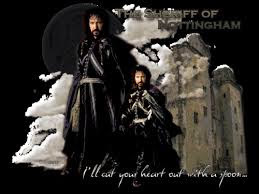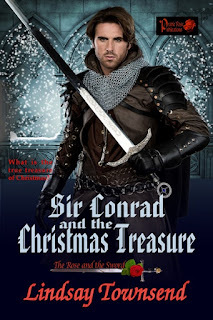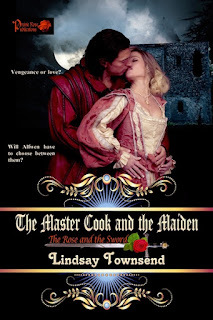The Sheriff of Nottingham. A Medieval Myth?
 Image from "Robin Hood, Prince of Thieves."
Image from "Robin Hood, Prince of Thieves."
The Sheriff of Nottingham – A Medieval Myth?
We remember the Sheriff of Nottingham, the ultimatemedieval ‘baddie’, enemy of Robin Hood, played with vigorous style by AlanRickman in “Robin Hood, Prince of Thieves.”
No records give this man’s name, only his title, yetthere never was a sheriff of Nottingham. So did this un-named villain exist?
One clue is in the title “Sheriff”, meaningshire-reeve, the reeve (royal officer) of the shire.
A further clue to the genesis of this myth is the factthat there was a High Sheriff of Nottinghamshire, Derbyshire and the RoyalForests, appointed by the Crown by the Normans soon after the Norman Conquestof 1066.
The Forest Laws were a Norman import, imposed uponAnglo-Saxon Laws and customs, and very much despised by the conqueredpopulation. The Forest Laws were a means by which the King could extend hisrule, eagerly used by monarchs to do just that. They could be imposed on morethan woodland or forest, and the High Sheriff, the creature of the King, washated as an enforcer of arbitrary, sometimes brutal laws. Forest Laws wereintended to reserve the red and fallow deer and the boar for the King and the aristocracy –and no one else. Dogs, apart from guard dogs, were forbidden in forest areas,and people were forbidden to carry hunting weapons. William Rufus, the son ofWilliam the Conqueror, increased the severity of the laws in the royal foreststo include death and mutilation. Such sentences seem to have rarely imposed,but such laws caused resentment.
King William II Rufus died in the royal New Forest,struck by an arrow. Political assassination or an angry local, furious at thelaws?
Another reason why the foil of Robin Hood was a sheriffwas because, in history, so many sheriffs or high sheriffs were bad lots.Philip Mark, sheriff from 1209 to 1224, Henry de Faucemberg (!318 to 1319) andJohn de Oxenford (1334 to 1339) were all corrupt, robbing and extorting with awill. ‘Gentlemen’ gangs of younger sons of the landed gentry, trained forbattle and with no lands to inherit, took readily to robbery and more. Men suchas the Folvilles and the Coterels actively recruited royal and other officialsto help them murder and steal. In 1335 Nicholas Coterel was even made bailifffor the High Peak District of Derbyshire, the ultimatehuntsman-turned-gamekeeper!
Given the danger for breakers of the king’s laws,poachers in the royal forest areas were often celebrated and praised. Few whobenefited protested, especially if they might receive a share of fresh, tastymeat.
Woodland, forests and hunting feature in many of mymedieval stories. I have Magnus, the hero in “The Snow Bride” involved in anassassination attempt in northern woodland during a hunt, and Conrad, the heroof “Sir Conrad and the Christmas Treasure” is a steward of the forest high lands.I speak of poaching, hunting and magic done to aid both in my novel, “The MasterCook and the Maiden”. All three of these novels are available on Amazon andfree to read through Kindle Unlimited. Why not give them a try?

"The Snow Bride"
"Sir Conrad and the Christmas Treasure."

"The Master Cook and the Maiden."

Lindsay



